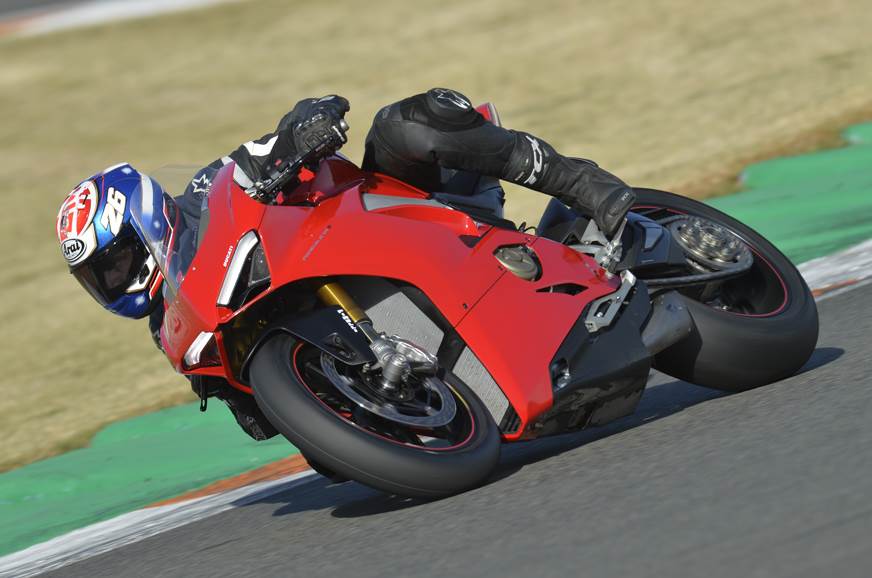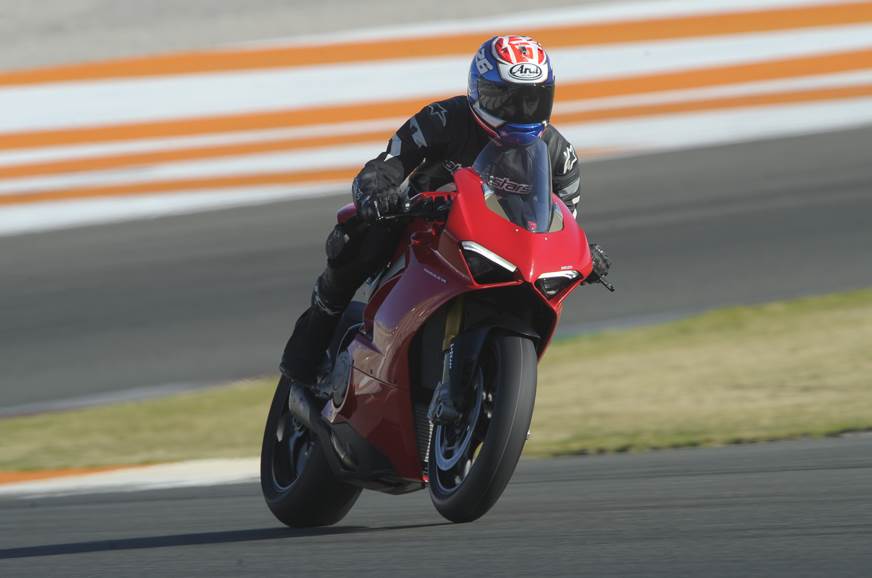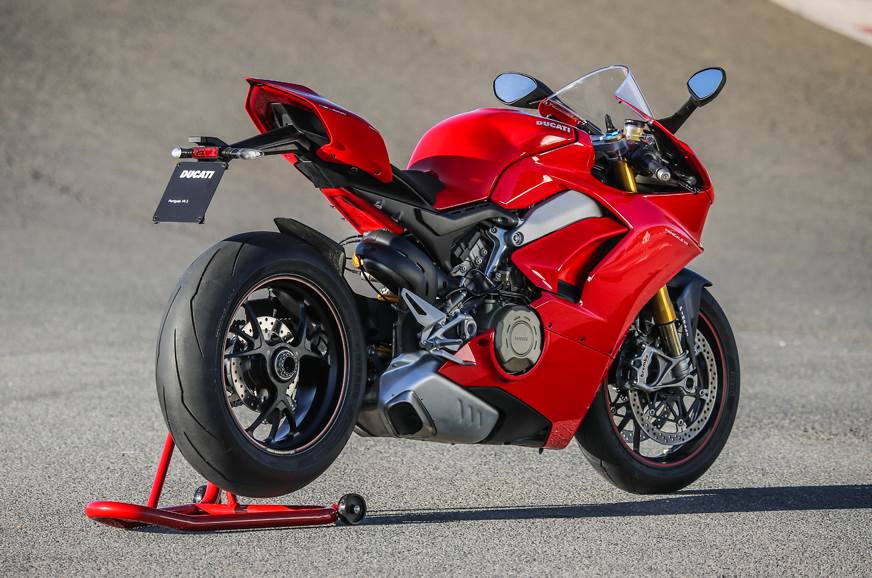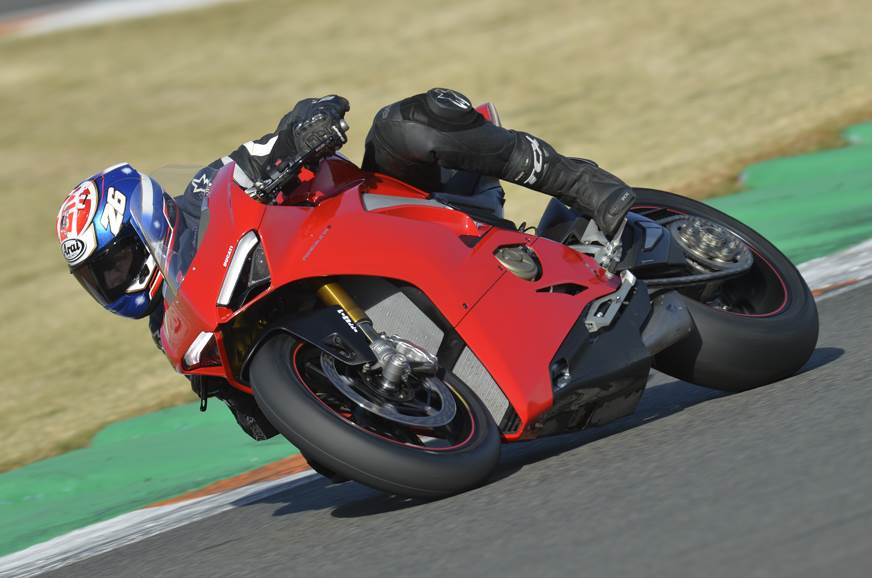
When the numbers were first released, they caused quite a stir. With 214hp of peak power, Ducati’s new Panigale V4 instantly became the most powerful production sports bike that money can buy. And with a bit more money, that power could be bumped up to an almost ludicrous 226hp through an optional Akrapovic exhaust and an engine remap. With its new chassis and claimed segment-leading electronics, the Panigale V4 was certain to be a very special machine. Well, we’ve just ridden it at the MotoGP circuit in Valencia, Spain – and suffice to say, our socks have been blown well and truly into the distance.
Valencia is an unusual place to organize the first ride experience for a machine that is the fastest of its class. The Spanish track is notorious for how tight and technical it is; and despite five riding sessions, many of us never fully figured it out. The rationale behind the decision was for Ducati to prove that the new Panigale V4 isn’t just a bull that can tear through a china shop at a million miles an hour. And thus, Valencia proved to be quite a smart choice, as it highlighted that the V4 is just as beautiful to ride in the corners as its sensational new design. Speaking of, it’s still very much recognizable as a Panigale, but the design has traded some of Ducati’s traditional clean and classic lines along the side, in favour of a more tight and muscular form.
Lurking beneath – what is easily some of the best-looking bodywork on a current sports bike – is a new frame. In fact, this is the first time in a while that Ducati has used the word ‘frame’ for its top superbike. The previous generation Panigale 1299 and Panigale 1199 both used a revolutionary monocoque structure inspired by Casey Stoner’s MotoGP bike that brought the benefits of a super-lightweight package. However, the monocoque wasn’t perfect and the primary issue was that it was too rigid, which reduced rider feel and feedback and made the bike harder to ride fast.

So, just as the Ducati MotoGP project returned to a twin-spar aluminum perimeter frame, the engineers looked at a similar solution for the road bike. However, a traditional beam frame was working out to be too heavy, so the result was this new ‘front-frame’ concept. This is essentially a smaller frame mounted to the front of the V4 engine, while the rear bank of cylinders is attached to the swingarm and rear sub-frame, which also connects to the end of the front frame. In all, the new frame contributes to the V4 S’ low kerb weight of 195kg – just 4.5kg heavier than the previous V-twin powered Panigale.
V-twin engines are the essence of a Ducati sports bike, so switching to a V4 was clearly a big decision. The call was made primarily because of the packaging challenges posed by V-twin engines that were steadily getting larger and larger in the quest to match and beat the latest four-cylinder rivals. The fact that the Panigales are the only generation of a Ducati superbike to have never won a WSBK title plays a role here, too.
Coming back to the engine, the new motor is more compact in terms of length and height, but grows in width by 43mm. The engine is rotated backwards by 42 degrees, which makes additional room for larger radiators and also allows a further forward swingarm pivot point. The 81mm bore, 90-degree V-angle as well as a ‘twin-pulse’ firing order are shared with the V4 engine in the MotoGP. However, Ducati stroked the motor out to displace 1,103cc, primarily for the purpose of offering a strong swell of torque that would be highly appreciated on a road bike. A 1,000cc racing version will be developed to meet the regulations of WSBK by 2019.

The engine uses a clever variable valve-timing system that varies the intake-track length based on the performance requirement. Another lesson taken from MotoGP comes in the counter-rotating crankshaft which spins in the opposite direction to the rear wheel. This combats the gyroscopic effect of the wheels, which results in better agility. It also works against the inertia generated by the rear wheel and helps keep the front wheel down under hard acceleration and while also reducing the tendency of the rear wheel to lift under heavy braking.
Both the Panigale V4 and V4 S share identical engine specs – 214hp and 124Nm of toque, with a lofty 14,500rpm rev limit. A compression ratio of 14:1 means this engine has a thirst for high-octane fuel, something worth keeping in mind. Ducati says that they’ve retained some of the feel and character of the V-twin in the new V4 and that’s evident the moment you fire the engine up. The motor settles into a gruff and mechanical-sounding idle with a fair amount of clatter, quite like the V-twin. But the sound transitions into a mean and angry bark at higher revs which is quite reminiscent of the Ducati MotoGP bike.
The Panigale goes just as fast as it sounds, too, pulling incredibly hard after 8,000rpm, all the way to the redline. It’s a struggle just to hold onto the bike under full acceleration and the bike was accelerating strongly even at 285kph, which was the fastest I dared before hauling on the anchors for turn 1. Power delivery is quite linear and predictable and the throttle response is smooth, as well, allowing the rider to comfortably roll on the gas when leaned over in a corner. All this power arrives cleanly from the V4, which is devoid of any irritating buzz or vibrations. That said, it has a likeable feel and texture and certainly isn’t as turbine-smooth as a Japanese inline-four.
The handling is the most natural I’ve experienced on a Ducati sports bike, till date. Turn-in is quick and the front-end conveys more agility and rider feedback than even the smaller 959 Panigale. That counter-rotating crank is almost certainly helping with the agile corner entry. In the middle of the corner, the bike feels supremely planted and the new Pirelli Supercorsas, with a taller 60 profile at the rear, provide immense grip. The Ohlins semi-active, electronically-controlled suspension is surprisingly organic and also offers a deep level of tuning ability for the rider. At this point, I’m not sure if the Panigale is among the easiest of the current-litre bike crop but it certainly feels like one of the fastest and most advanced.

Then there are the brakes, which are simply the finest I’ve ever used. The V4 is the first road bike to use Brembo’s new Stylema front callipers, which are a more compact and lighter evolution of the previous range-topping M50s. Braking performance is immensely powerful, with good feel and progression at the lever and the brakes showed no sign of fade, throughout a day of very hard riding.
And finally, that brings us to the segment leading electronics. There’s simply far too much to write about, here – not just in terms of electronic assists but also the engine and chassis. So you should check out the separate technology piece on our website. But to sum up, the Panigale V4 features an evolved electronics package from the 1299 Panigale which offers even smoother and more intuitive intervention. There are quite a few additions as well, and the highlights include the new Slide-by-Brake feature that allows the rider to use the rear brake to put the bike into a controlled drift while entering a corner. Slide Control, meanwhile, allows carefully-managed slides when the bike is leaned over and the rider gets on the throttle during corner exit. Anti-Wheelie also does a good job of restraining the front wheel – which is eager to come up under hard acceleration all the way upto 4th gear, and well over 220kph. All the assists offer high levels of adjustability and can be easily controlled via switches on the left bar and through the crisp new 5.0-inch, full colour display.
The Panigale V4 is a true exotic, in every sense of the word. It’s achingly gorgeous and mentally fast, but it does so with an ease and sophistication that very few exotics possess. But the really good news comes in the form of the price. Since the new V4 is now assembled in Thailand, Ducati has been able to price the bike far more competitively than the previous 1299 Panigale. Both the V4 and the V4 S have been launched in India at a competitive Rs 20.53 lakh and Rs 25.29 lakh, respectively, although our market will only get 20 bikes in 2018. The base V4 seems like a particularly good deal, considering that it gets all the power and technology from the S apart from the electric Ohlins suspension, forged aluminium wheels and a lithium ion battery. Deliveries start in July and we can’t wait to ride these bikes in more familiar territory!
[“Source-autocarindia”]
